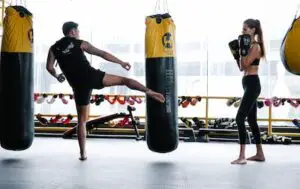Katori Aikido: the name carries a sense of mystique and intrigue, evoking images of disciplined warriors engaging in graceful movements. But what exactly is Katori Aikido? In this comprehensive guide, we will delve into the origins, philosophy, techniques, training, and benefits of this ancient martial art. From its historical roots to its modern-day practice, we will explore the transformative power of Katori Aikido and how it can enhance your physical fitness, mental focus, and spiritual well-being.
Origins of Katori Aikido
1.1 The Birth of Katori Shinto-ryu Katori Shinto-ryu, the foundation of Katori Aikido, has its roots in ancient Japan. Founded in the 15th century by Iizasa Choisai Ienao, it is one of the oldest extant martial arts schools in Japan. Ienao was inspired by the teachings of the Shinto religion and integrated these principles into the martial art, emphasizing the harmonious connection between humans and nature.
1.2 Katori Aikido: The Evolution of a Martial Art Katori Aikido, as developed by Morihei Ueshiba, the founder of Aikido, draws upon the principles and techniques of Katori Shinto-ryu. Ueshiba sought to create a martial art that transcended aggression and focused on redirecting and neutralizing an opponent’s energy. He incorporated the fluid movements and philosophy of Katori Shinto-ryu into his own practice, leading to the birth of Katori Aikido.
Philosophical Foundation
2.1 Harmony and Balance At the core of Katori Aikido is the concept of harmony and balance. Practitioners learn to blend with their opponent’s energy and redirect it without engaging in direct confrontation. This philosophy extends beyond the physical realm and can be applied to daily life, fostering a sense of harmony in interpersonal relationships.
2.2 The Way of the Sword The sword, or “ken,” plays a significant role in Katori Aikido. The art incorporates sword techniques and katas that not only enhance martial proficiency but also deepen practitioners’ understanding of the art’s principles. The sword symbolizes discipline, focus, and the pursuit of excellence.
2.3 Mindfulness and Presence Katori Aikido emphasizes mindfulness and being fully present in the moment. By cultivating a heightened sense of awareness, practitioners develop the ability to anticipate and respond effectively to their opponent’s movements. This mindfulness practice extends beyond the dojo, enhancing overall mental focus and concentration.
Fundamental Techniques
3.1 Basic Movements and Footwork Katori Aikido begins with mastering basic movements and footwork. These include stances, pivots, and proper body alignment. These foundational elements establish a solid base for further development of techniques.
3.2 Sword Techniques and Katas The study of sword techniques and katas is an integral part of Katori Aikido. Practitioners learn the proper grip, posture, and striking techniques with the sword, allowing them to develop precision, timing, and spatial awareness.
3.3 Joint Locks and Throws Katori Aikido incorporates joint locks and throws, known as “nage waza,” as effective techniques for neutralizing an opponent. These techniques utilize the principle of redirection and leverage, allowing practitioners to immobilize or redirect an attacker’s energy with minimal force.
Training and Dojo Etiquette
4.1 Traditional Training Methods Katori Aikido training follows a structured approach, emphasizing discipline, respect, and perseverance. The training typically includes warm-up exercises, drills, partner practice, and the study of forms and techniques. Regular practice is essential for progress and mastery of the art.
4.2 The Role of the Dojo The dojo, or training hall, holds great significance in Katori Aikido. It is a space dedicated to focused training and personal growth. Dojos often have specific rules and protocols, fostering an environment of respect, humility, and mutual support among practitioners.
4.3 Etiquette and Rituals Katori Aikido places importance on etiquette and rituals. Bowing, proper attire, and respectful behavior towards instructors and fellow practitioners are integral parts of the training experience. These rituals instill discipline, humility, and a sense of unity within the dojo community.
Benefits of Practicing Katori Aikido
5.1 Physical Fitness and Flexibility Katori Aikido offers a complete physical workout, improving strength, endurance, and flexibility. The art’s dynamic movements engage various muscle groups, enhancing overall fitness levels and promoting a healthy body.
5.2 Self-Defense Skills With its emphasis on redirecting and neutralizing an opponent’s energy, Katori Aikido equips practitioners with practical self-defense skills. By learning to control and subdue an attacker without relying on brute force, practitioners gain confidence and the ability to protect themselves and others.
5.3 Improved Coordination and Balance The intricate footwork, precise techniques, and fluid movements of Katori Aikido enhance coordination and balance. Practitioners develop heightened body awareness, agility, and the ability to move fluidly in various directions.
5.4 Mental Focus and Discipline The mental aspect of Katori Aikido is as vital as the physical. The art’s practice requires intense concentration, focus, and discipline. Regular training cultivates mental resilience, clarity, and the ability to remain calm and composed under pressure.
5.5 Stress Relief and Emotional Well-being Engaging in Katori Aikido can provide stress relief and promote emotional well-being. The practice allows practitioners to release tension, increase mindfulness, and develop a sense of inner calm. It offers an opportunity to disconnect from daily pressures and find balance.
5.6 Cultivation of Spiritual Growth Katori Aikido’s philosophical foundation fosters spiritual growth. The art encourages practitioners to explore their inner selves, promoting self-reflection, introspection, and the development of a deeper connection with the world around them.
Frequently Asked Questions
6.1 What is the difference between Katori Shinto-ryu and Katori Aikido? 6.2 Can anyone practice Katori Aikido? 6.3 How long does it take to become proficient in Katori Aikido? 6.4 Is Katori Aikido suitable for self-defense? 6.5 Can Katori Aikido be practiced by children? 6.6 Are there any competitions or tournaments in Katori Aikido?
Conclusion
In conclusion, Katori Aikido offers a rich and rewarding journey for those seeking physical, mental, and spiritual growth. Its origins steeped in history, the philosophical foundation it rests upon, and the comprehensive training it provides make it a unique and powerful martial art. By practicing Katori Aikido, individuals can develop not only their physical abilities but also cultivate a harmonious way of life. Whether you are a martial arts enthusiast or simply intrigued by Japanese culture, Katori Aikido is an art worth exploring for its holistic benefits. Embrace the path of Katori Aikido, and discover the transformative power it holds for your mind, body, and spirit.





